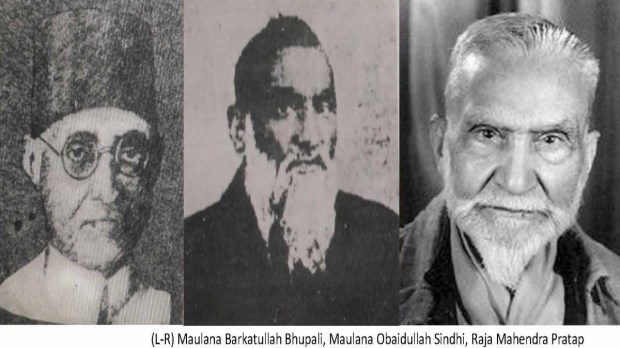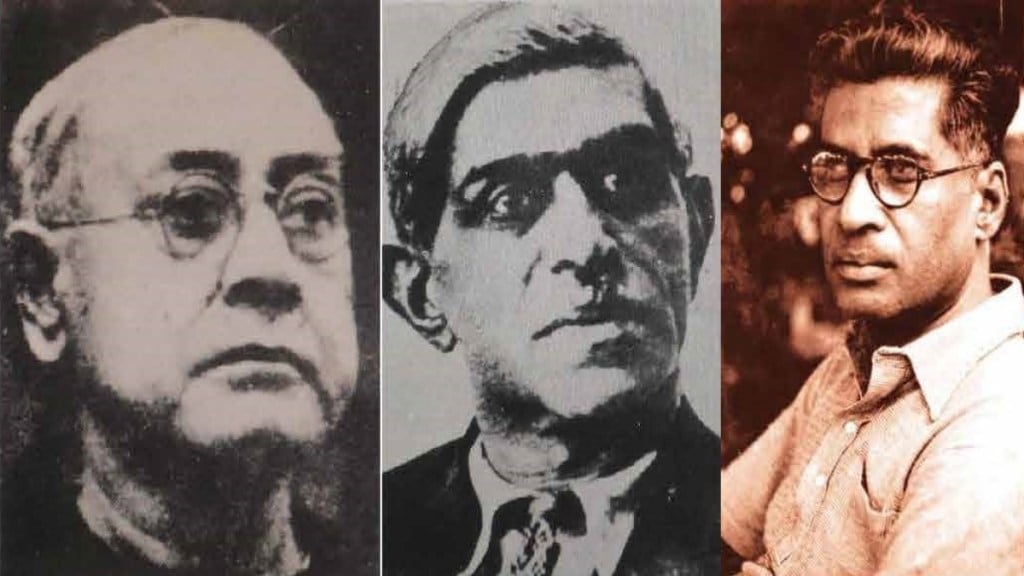By Raju Mansukhani
The recently-concluded Raisina Dialogue 2024 once again brought home the message of India’s stable, very friendly relationship with Russia. Said External Affairs Minister S Jaishankar, “Russia is a power with an enormous tradition of statecraft.” The Minister’s words were in fact a bridge to a historic past, to the last 100 years when anti-colonial leaders in India were deeply influenced, inspired, and impacted, by the rise of the USSR (Union of Soviet Socialist Republics) in 1917.
The list of political revolutionaries and leaders includes the legendary MN Roy, Raja Mahendra Pratap, Virendranath Chattopadhyay (also known as ‘Chatto’), Dr Bhupendranath Datta, and the lesser-remembered Maulana Obaidullah Sindhi and Maulana Barkatullah Bhupali to name a few.
The Indo-Russian bridge has a landmark date: 26 August 1921. The Russian leader Vladimir Lenin, who forged the Bolshevik Revolution in 1917, wrote a short letter that day: “Dear Comrade Datta, I have read your thesis. We should not discuss about the social classes. I think we should abide by my thesis on colonial questions. Gather statistical facts about Peasant leagues if they exist in India.” It was signed by the iconic revolutionary, the first head of the USSR.
Readers today may not be aware that Comrade Datta to whom the letter was addressed was none other than Dr Bhupendranath Datta, a fiery revolutionary in his own right, and better known (some would say, overshadowed) by his brother Narendranath Datta whom the world reveres as Swami Vivekananda.
In his correspondence with Lenin, the young Dr Datta audaciously commented on Lenin’s thesis for which the Soviet leader gave a firm answer, getting the young Indian revolutionary to focus on work in India. This letter was published in 1952, in ‘Dialectics of Land Economics in India’, a book of Dr Bhupendranath.
It is not merely the concern of Lenin which this short letter establishes; nor the young Indian comrade’s courageous comments but the deep-rooted ideological, intellectual, and highly inspirational ties between revolutionaries in India, Russia and across European countries. Their dialogue, just as the Raisina Dialogue 2024, was multi-layered interaction which had diverse outcomes, besides forging ties based on mutual friendship and faith.
Dr Bhupendranath’s life and work exemplifies the impact of global ideas on Indian revolutionaries who were relentless, unafraid in challenging the ruthless British Raj. Dr Bhupendranath was editor of Jugantar weekly which began in April 1906, till the editor was sentenced for seditious editorials. Later, revolutionaries who contributed or managed this paper came to be known as belonging to the Jugantar Party. In 1907 an illegal leaflet of the revolutionaries (Sonar Bangia) was published: for the first time, the Russian revolution of 1905 was referred to.

The dramatic life of Dr Bhupendranath Dutta continued, after his imprisonment he escaped to the USA. When the First World War broke out, he reached Germany and joined the Berlin Committee. In 1916 he became its secretary; in 1921, accompanied by Virendranath Chattopadhyay and other members of the Committee, he went to Moscow. As a result of his correspondence with Lenin, he became a Marxist. In 1925, he returned to India, propagated Marxism, and became a leading organiser of workers and peasants’ movements. These fascinating stories, facts and profiles are documented in ‘India’s Struggle for Freedom – An Album’, published by the West Bengal Government in 1987.
The Berlin Committee formed in 1915 was a platform bringing together Indian revolutionaries in England, France or in Germany. Virendranath Chattopadhyay became its leader, and with him were Sri Krishna Verma and Madam Bhikaji Cama. Berlin Committee, also referred to as India Independence Committee, witnessed participation of a motley cast of revolutionaries: Raja Mahendra Pratap, Dr Bhupendranath Dutta, Dr Champak Raman Pillai, Dr Abinash Bhattacharya, Maulana Barkatullah, Dadachanji Kersasp, Promothonath Dutta, Jitendranath Lahiri and Birendranath Dasgupta, to name a few.
During this period Virendranath was the main organiser of worldwide anti-British revolutionary activities. The Berlin Committee established contact with the Ghadr Party in USA and Canada; members were sent to Constantinople, Baghdad, Iran, Afghanistan to organise revolutionary activities. In 1917, Virendranath went to Stockholm and in 1920-21, he was in Moscow; he returned to Germany and joined the German Communist Party. In 1927 he became one of the General Secretaries of the League Against Imperialism. In 1932 when the Nazis became powerful in Germany, he made the Soviet Union his home. He died there in 1943. Few would be aware that Virendranath Chattopadhyay was the brother of Sarojini Naidu, hailed as the ‘Nightingale of India’, a close associate of Mahatma Gandhi and Pt Jawaharlal Nehru.
Raja Mahendra Pratap, who gave up the title ‘Raja’ and donated most of his land in India, was another revolutionary criss-crossing Europe and Asia. At the request of the Berlin Committee in 1915, he went to Kabul as leader of a German-Turk- Indian mission. On 1 December 1915, he set up a Provisional Free Indian Government in Kabul and became its President. On 7 May 1919, he met Lenin as the leader of an Indian delegation consisting of 5 persons. After many years of exile, he was allowed to return to India when Pt. Jawaharlal Nehru became the Prime Minister of the Interim Government in 1946.
A senior leader of Ghadr Party, Maulana Barkatullah Bhupali also reached Germany to join the Berlin Committee. In 1915, he was a member of Mahendra Pratap’s mission to Kabul and became the Prime Minister of the Provisional Free Indian Government. He was also in the Indian delegation which met Vladimir Lenin on 7 May 1919. At the Brussels Conference of League Against Imperialism in 1927, he was present with Virendranath Chattopadhyay and Pt Jawaharlal Nehru.
Maulana Obaidullah Sindhi, a teacher at Deoband Centre of Islamic Studies, selected a group of 15 students and secretly they left for Kabul while the war was in progress. They declared ‘jehad’ against the British; and were known as Mujahid. Their aim was to rouse the entire Muslim world in a struggle against the British. He was detained for years in Malta. Meanwhile Maulana Obaidullah was appointed ‘Home Minister in the Provisional Free Indian Government’ at Kabul.
Maulana Obaidullah’s journey of courage: In 1922, he took ten Indian revolutionaries from Kabul to Tashkhand. They reached Moscow to attend classes at University of the Toilers of the East. In 1926, Maulana Obaidullah published a document called ‘Constitution of Free India’ from Istanbul. ln his autobiography, Pt. Jawaharlal Nehru praised the document as an excellent effort to solve the complex communal problem in India.
The Berlin Committee, and its heroic cast of revolutionaries, foretell the story of Netaji Subhas Chandra in 1941 when he reached Germany, vowing to bring down the British Empire and building a volunteer Indian National Army.
Manabendranath Ray, Narendranath Bhattacharya, M.N. Roy: this was one leader who had many names and deep roots in Russian politics. He was part of the Jugantar Party, left India during the First World War in search of German arms, and later reached Japan, then USA where he took the name of Manabendranath Ray. In 1917 when U.S.A. joined the War on the side of the Allies, he was arrested along with Ghadr revolutionaries. Once on bail, he and his American wife fled to Mexico. In Mexico, Roy met the famous Russian Bolshevik, Borodin. As a result of his influence, Roy became a communist. In Mexico he founded the socialist party and later a communist party.
When in April 1920, M.N. Roy reached Moscow, under Lenin’s advice he placed a supplementary thesis to Lenin’s thesis on tactics for revolutionaries of subjugated countries in the second Congress of the Communist International. Later he was elected member of the Executive Committee of the Communist International. Abani Mukherjee, Tirumal Acharya, M.N. Ray, Evelyn Ray and Md. Shafique were members in the second Congress of Communist International.
Sang the poet Subrahmanya Bharati in 1917, “There are no slaves any more, nor ill-gotten wealth to slavery/Like a shattered wall the present age lies on the ground/The golden age is about to come.” Mohammed Iqbal wrote, “Now at last, one can discern some signs / Which portend the triumph of reason over fate. / The wisemen of yore are brooding over the fact / That the entire structure of their domain is shaken to the very foundation.”
The saga of India and Russia ties has grown through colonial times, wars, peace, and present-day globalization.
Author is a writer-researcher on history and heritage issues; former deputy curator of Pradhanmantri Sangrahalaya.
Disclaimer: Views expressed are personal and do not reflect the official position or policy of Financial Express Online. Reproducing this content without permission is prohibited.

